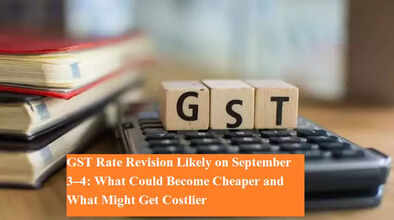GST Rate Revision Likely on September 3–4: What Could Become Cheaper and What Might Get Costlier

The central government is preparing for a significant reform in the Goods and Services Tax (GST) structure. The upcoming GST Council meeting, scheduled for September 3 and 4 in New Delhi, is expected to take a final decision on proposed rate changes across multiple sectors. Sources suggest that while certain essential items may see a reduction in GST, others could face higher tax rates to balance revenue without hurting economic growth.
Major Restructuring on the Cards
According to officials, the Group of Ministers (GoM) is likely to recommend merging the existing 12% and 18% tax slabs. If approved, this restructuring will lead to adjustments in the tax rates of several goods and services. The government aims to rationalize GST in a way that supports growth, keeps prices of essentials under check, and minimizes revenue loss.
Items Expected to Get Cheaper
One of the key proposals is to reduce GST on fertilizer acids (currently at 18%) and bio-pesticides (currently at 12%) to just 5%. This move is expected to lower agricultural input costs significantly, ultimately benefiting farmers and reducing overall cultivation expenses.
Similarly, the government is planning to cut GST on renewable energy products. Items such as solar cookers, solar water heaters, and related parts, which are currently taxed at 12%, may soon fall under the 5% bracket. This decision is aimed at boosting green energy adoption and promoting sustainable growth.
In addition, the textile industry may receive a much-needed relief. GST on synthetic yarns, sewing threads, man-made staple fibers, felts, metallized yarns, rubber threads, carpets, and gauges could be reduced from 12% to 5%. The sector, which has been under pressure from rising input costs, may see an improvement in competitiveness.
Footwear under ₹2,500 is also expected to become cheaper, with GST likely to be reduced from 12% to 5%. This will directly benefit the middle-class consumer base.
Items That May Become Costlier
To balance the revenue impact of these cuts, the government is considering increasing GST rates on certain categories. For instance, coal, briquettes, and other solid fuels, currently taxed at 5%, may move up sharply to 18%. This would help the government offset revenue loss but could increase power generation costs.
On the apparel front, a major adjustment is being planned. Currently, garments priced up to ₹1,000 attract a 5% GST. This threshold may be increased to ₹2,500, giving relief to budget-conscious buyers. However, apparel priced above ₹2,500 may soon be taxed at 18% instead of the current 12%.
For footwear, while pairs costing less than ₹2,500 may see reduced tax, those priced above ₹2,500 could face a hike from 12% to 18%. This restructuring is designed to make basic consumer goods more affordable while ensuring luxury or premium items contribute more to the exchequer.
Balancing Growth and Revenue
The central government’s overall approach is to strike a balance between supporting economic growth and protecting revenue collections. By reducing GST on agriculture inputs, renewable energy products, and textiles, the government is sending a signal of support to critical and emerging sectors. At the same time, increasing taxes on higher-end apparel, footwear, and coal ensures that revenue does not decline sharply.
What Happens Next?
The proposals will be reviewed and finalized during the GST Council meeting on September 3–4. If approved, the revised rates could be officially notified by the end of September 2025. Businesses and consumers alike are keenly awaiting the outcome, as the changes are expected to directly impact household budgets and industry costs.
Final Word
The upcoming GST reforms are being seen as one of the most significant steps since the tax was first introduced. With a mix of rate cuts on essentials and hikes on premium or non-essential items, the government is attempting to simplify the structure, promote green energy, support farmers, and provide relief to middle-class households—while ensuring revenue stability.
For consumers, this means essentials like bio-pesticides, fertilizers, textiles, solar products, and affordable footwear may soon become cheaper, while coal, premium footwear, and high-end apparel could burn a bigger hole in the pocket.

